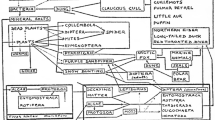Abstract
The Hutchinsonian concept of the ecological niche can be made operational for studies in human ecology by defining it in terms of thedistinctive ways of using resources for subsistence that set “cultural species” apart. Subsistence variety, the number of resources used for subsistence, and how much each is depended on are measures of distinctiveness, and the amount of variety present can be defined as thewidth of the ecological niche. The calculation of niche width from subsistence data is discussed, and examples are given from several human groups with reference to total resource variety, resource variety in space, and resource variety in time. The importance of selecting niche dimensions for niche width measurement is stressed, and examples are given of width differences resulting from measuring variety in quantity (biomass or calories) and variety in quality (protein, essential minerals, etc.). Finally, some implications of niche width measurements for human ecology are discussed.
Similar content being viewed by others
References
Alkire, W. H. (1965).Lamotrek Atoll and Inter-Island Socioeconomic Ties, Studies in Anthropology, No. 5, University of Illinois Press, Urbana, Ill.
Aschmann, H. (1959).The Central Desert of Baja California: Demography and Ecology, Ibero-Americana, Berkeley and Los Angeles, No. 42.
Boserup, E. (1965).The Conditions of Agricultural Growth, Aldine, Chicago.
Chagnon, N. (1968).Yanomamo: The Fierce People, Holt, Rinehart and Winston, New York.
Coe, M. D., and Flannery, K. V. (1964). Microenvironments and Mesoamerican prehistory.Science 143: 650–654.
Colwell, R. H., and Futuyma, D. J. (1971). On the measurement of niche breadth and overlap.Ecology 52(4): 567–576.
Downs, J. (1966).The Two Worlds of the Washo, Holt, Rinehart and Winston, New York.
Dumond, D. (1972). Population growth and political centralization. In Spooner, B. (ed.),Population Growth: Anthropological Implications, MIT Press, Cambridge, Mass., pp. 286–310.
Flannery, K. V. (1968a). Archaeological systems theory and early Mesoamerica. In Meggers, B. (ed.),Anthropological Archaeology in the Americas, Anthropological Society of Washington, Washington, D.C., pp. 67–87.
Flannery, K. (1968b). The ecology of early food production in Mesopotamia.Science 147: 1247–1256.
Flannery, K. (1969). Origins and ecological effects of early domestication in Iran and the Near East. In Ucko, P. J., and Dimbleby, G. W. (eds.),The Domestication and Exploitation of Plants and Animals, Aldine, Chicago, pp. 73–100.
Hardesty, D. L. (1972). The human ecological niche.American Anthropologist 74(3): 458–466.
Hardin, G. (1960). The competitive exclusion principle.Science 131: 1291–1297.
Hawley, A. (1973). Ecology and populations.Science 179: 1196–1201.
Hutchinson, G. E. (1957). Concluding remarks.Cold Spring Harbor Symposia on Quantitative Biology 22: 415–427.
Hutchinson, G. E. (1965).The Ecological Theater and the Evolutionary Play, Yale University Press, New Haven.
Jordon, C. F. (1971). A world pattern in plant energetics.American Scientist 59(4): 425–433.
Kemp, W. B. (1971). The flow of energy in a hunting society.Scientific American 224(3): 104–115.
Klein, R. G. (1969).Man and Culture in the Late Pleistocene, Chandler, San Francisco.
Klopfer, P. H. (1971).Behavioral Aspects of Ecology, 2nd ed., Prentice-Hall, Englewood Cliffs, N.J.
Knudson, K. E. (1970). Resource fluctuation, productivity, and social organization on Micronesian coral islands. Unpublished Ph.D. thesis, University of Oregon.
Lee, R. (1968). What hunters do for a living, or how to make out on scarce resources. In Lee, R. B., and DeVore, I. (eds.),Man the Hunter, Aldine, Chicago, pp. 30–48.
Lee, R. B., and DeVore, I. (eds.) (1968).Man the Hunter, Aldine, Chicago.
Levins, R. (1968).Evolution in Changing Environments, Princeton University Press, Princeton, N.J.
MacArthur, R. (1968). The theory of the niche. In Lewontin, R. C. (ed.),Population Biology and Evolution, Syracuse University Press, Syracuse, N.Y., pp. 159–176.
MacNeish, R. (1964). Ancient Mesoamerican civilizations.Science 143: 531–537.
Margalef, R. (1968).Perspectives in Ecological Theory, University of Chicago Press, Chicago.
Neale, W. C. (1957). Reciprocity and redistribution in the Indian village: Sequel to some notable discussions. In Polanyi, K., Arensberg, C. M., and Pearson, H. W. (eds.),Trade and Market in the Early Empires, Free Press, Glencoe, Ill., pp. 218–236.
Nietschmann, B. (1973).Between Land and Water, The Subsistence Ecology of the Misquito Indians, Eastern Nicaragua, Seminar Press, New York.
Odum, E. (1971).Fundamentals of Ecology, 3rd ed., Saunders, Philadelphia.
Oswalt, W. H. (1973).Habitat and Technology: The Evolution of Hunting, Holt, Rinehart and Winston, New York.
Piddocke, S. (1965). The potlatch system of the Southern Kwakiutl: A new perspective.Southwestern Journal of Anthropology 21: 244–264.
Pospisil, L. (1963).Kapauku Papuan Economy, Yale University Publications in Anthropology, No. 67, Yale University Press, New Haven.
Rappaport, R. (1968).Pigs for the Ancestors, Yale University Press, New Haven.
Rappaport, R. (1971). Nature, culture, and ecological anthropology. In Shapiro, H. (ed.),Man, Culture and Society, rev. ed., Oxford University Press, New York, pp. 237–267.
Rogers, E. S. (1972). The Mistassini Cree. In Bicchieri, M. G. (ed.),Hunters and Gatherers Today, Holt, Rinehart and Winston, New York, pp. 90–137.
Roughgarden, J. (1972). Evolution of niche width.American Naturalist 106: 683–718.
Silberbauer, G. B. (1972). The Gwi Bushmen. In Bicchieri, M. G. (ed.),Hunters and Gatherers Today, Holt, Rinehart and Winston, New York, pp. 271–326.
Steward, J. H. (1938).Basin-Plateau Aboriginal Sociopolitical Groups, Bulletin 120, Smithsonian Institution, Bureau of American Ethnology, Washington, D.C.
Vandermeer, J. H. (1972). Niche theory.Annual Review of Ecology and Systematics 3: 107–132.
Vayda, A., and Rappaport, R. (1968). Ecology, cultural and non-cultural. In Clifton, J. (ed.),Introduction to Cultural Anthropology, Houghton Mifflin, New York, pp. 477–497.
Wagner, G. (1954).The Bantu of North Kavirondo, Vol. II:Economic Life, Oxford University Press, New York and London.
Whittaker, R. H. (1970).Communities and Ecosystems, Macmillan, New York.
Author information
Authors and Affiliations
Rights and permissions
About this article
Cite this article
Hardesty, D.L. The niche concept: Suggestions for its use in human ecology. Hum Ecol 3, 71–85 (1975). https://doi.org/10.1007/BF01552263
Received:
Revised:
Issue Date:
DOI: https://doi.org/10.1007/BF01552263




